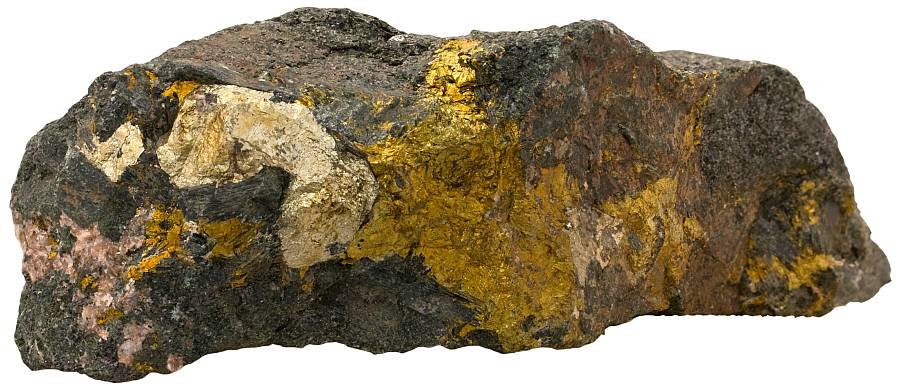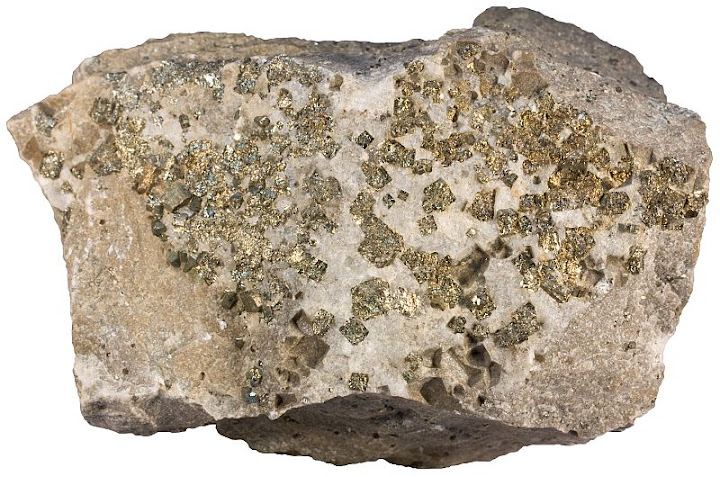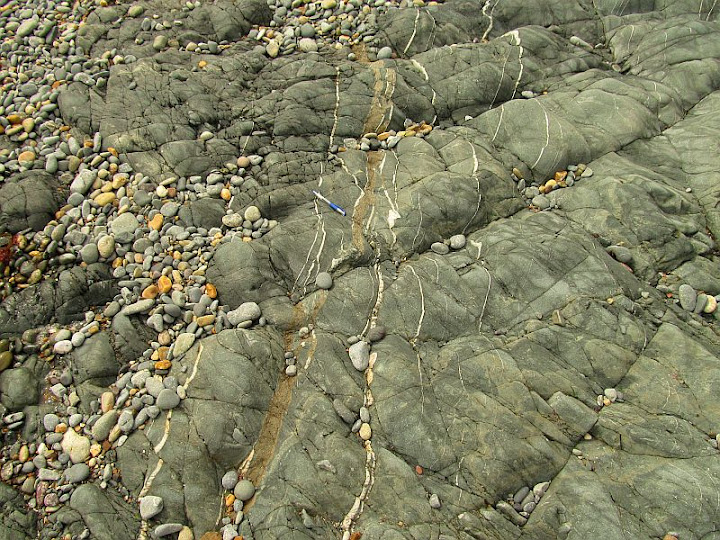Pyrite is the most abundant and widespread sulfide mineral (FeS2). It rarely makes up the bulk of the rock, but it frequently occurs in rocks. It is a common mineral in sedimentary rocks, especially if they contain or contained organic matter. It is also a very common hydrothermal mineral. Few hydrothermal veins are without it. Especially common association is pyrite with quartz.

Sedimentary rock shale containing cubes of pyrite and veins of quartz. Width of sample 8 cm. TUG 1608-2799.
Pyrite is an iron sulfide. Sulfur managed to combine with iron because its strongest competitor oxygen was nowhere to be found. Oxygen was consumed by decomposing organic matter or maybe we should say it the other way around: oxygen was busy destroying the organic stuff and lost its freedom in the process. This is why we often find it in coal and black shales. They both contain organic matter that was preserved because there were not enough oxygen available to destroy it all. This also gave chance to pyrite.
Hydrothermal pyrite has been frequently mistaken for gold and therefore the name fool’s gold. It is much more common than gold and it is not very difficult to tell them apart. Pyrite is a hard mineral (Mohs hardness over 6) but gold is soft. It is easy to scratch pure gold with a knife or needle. You can not do it with pyrite. Its crystals are brittle but gold is malleable.
Also the color is different. Gold is bright golden yellow, but pyrite is somewhat paler or even greenish yellow. In powdered form is greenish black. This is the color of a streak pyrite leaves on a streak plate. It is also significantly lighter in weight. Specific weights are about 5 and over 19 for pyrite and gold, respectively. However, despite the large difference, this property is not very useful to differentiate them because it is not very likely to find gold nuggets large enough to really feel their weight. Gold nuggets have a characteristic irregular and somewhat rounded shapes which is the result of their malleability. Pyrite is also irregular, but the cubic outline of individual crystals should be noticeable.
It is much harder to tell it apart from other similar sulfides like chalcopyrite, pyrrhotite, and marcasite. Chalcopyrite (CuFeS2) is brighter in color and softer (can be scratched by a knife). These two often occur together and if there is enough chalcopyrite they may be mined together as an ore of copper. Pyrrhotite is usually magnetic, darker in color and also scratched by a knife. The only real problem is marcasite. These minerals sometimes have a different habit but in many cases XRD analysis is needed to be sure.
Pyrite is not resistant in the weathering environment. It fairly quickly breaks up in contact with oxygen and water. This reaction oxidizes the iron and releases sulfur as a sulfuric acid. This reaction has given it a negative reputation as an environmentally very problematic mineral. This process is of course entirely natural and won’t cause significant problems in itself but in combination with mining (as an acid mine drainage) things can get a lot nastier. Acidic water pumped out or leaked from mines has a negative impact on ecosystems. It is not only harmful because of acidity, but also because acidic water carries lots of dissolved heavy metals. Many of which are harmful and eventually make their way to our food supply. The decomposition of pyrite is an exothermal process (heat is released) which means that mining dump heaps containing it may ignite spontaneously. Such subterranean fires release harmful compounds to the groundwater and are exceedingly difficult to put out. Water does not help, this is what pyrite needs to decompose and it is also foolish to open up burning hills because it will only bring in more oxygen. Hence, pyrite is a significant environmental headache and is one of the most important reasons why we often say that most fossil fuels are “dirty”.
Pyrite may have a negative reputation as an unwanted impurity in fossil fuels, but it is also mined as a mineral resource. It is composed of two chemical elements — sulfur and iron, which both have lots of industrial applications. However, it is usually is mined for its sulfur content. Banded iron formations which usually contain iron as oxides (magnetite, hematite) are much better ores of iron. Sulfur extracted from pyrite is mostly used to make sulfuric acid which has many industrial applications. Because of that it is said that the amount of sulfuric acid produced is a good indicator of country’s industrial strength. Sulfuric acid is used to make fertifizers, detergents, explosives, batteries, pharmaceuticals, etc.
Pictures

Crystals from Cyprus (the Troodos ophiolite). Such formation is known as VMS (volcanogenic massive sulfide).The mineral precipitated out of hot hydrothermal vents (black smokers) near the mid-ocean ridges. These deposits must be very widespread in the oceanic crust, but they only occasionally get squeezed between continental landmasses and become available to us.

It is often together with chalcopyrite and the minerals are therefore mined together. Chalcopyrite as a principal ore of copper is much more useful. Pyrite is paler yellow, chalcopyrite has more intense color. Width of sample 8 cm. Hannukainen, Finland.
Large boulder of massive sulfide from Cyprus. It is called massive because it is indeed full of pyrite and contains little else. Here is an example of pyrite as a rock type.
This sample of basalt, pyrite and quartz is part of a stockwork below the the massive sulfide lens in Cyprus. This is basaltic seafloow through which hot and metal-bearing water rose to form massive deposits on the seafloor above.
Beautiful but toxic. Acidic water filling former VMS mine in Cyprus.

Pyrite cubes and quartz in a vein that cuts through quartzitic rock. Width of sample is 11 cm.
Pyrite is afraid of water and oxygen but nature is full of surprises. Here is a beach sand in Cyprus that is largely composed of pyrite cubes (reddish part of the beach).

Sand sample from the same beach. Crystals are reddish because they are weathered (covered by goethite).
Disseminated pyrite in andesitic igneous rock. Southern Ireland. Width of view 10 cm.

Veins of pyrite and quartz in andesite in Southern Ireland.

Close-up of the same vein. Both minerals are very common in hydrothermal veins.

Rounded aggregates from Estonian carbonate sedimentary rocks. Width of view 5 cm.
good collections. If there is a line of some genetic aspect it will give more impact i feel. In few it is mentioned.
i’m going to ireland